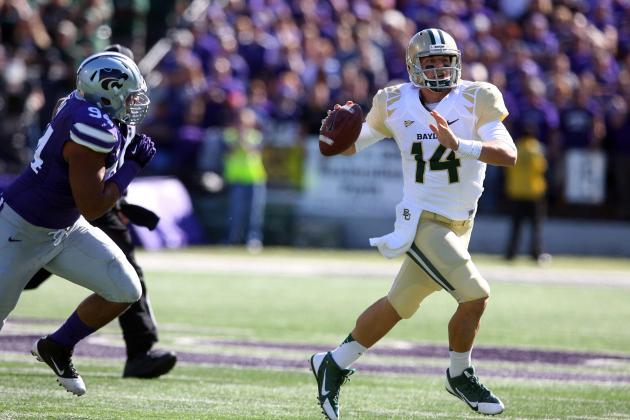Up-tempo offenses have revolutionized college football
The college football landscape is changing. This year, there is more parity within the major conferences than ever before. Just look at the Pac-12, as every team has at least one loss to a conference opponents.
USC still leads the Pac-12 South after nearly being handed its second conference loss at the hands of the Arizona Wildcats.

Bryce Petty and the Baylor Bears lead the FBS in total offense with 623 yards per game through six games. — photo courtesty of Scott Sewell, USA Today Sports
Although there are many factors that contribute to the balance of power across the college football world, the primary reason for this is the advent of the up-tempo, spread offense.
Many successful offensive coaches utilize the up-tempo spread offense. Chip Kelly most famously turned a consistently mediocre Oregon program into a perennial powerhouse that was just one possession away from winning a national championship.
Art Briles consistently puts up video game numbers within the Baylor offense and has turned that program around and Kevin Sumlin brought his up-tempo offense to Texas A&M, where he has averaged around 40 points per game.
Non-traditional powers such as Oregon, Baylor and Texas A&M have risen to elite status by incorporating their respective versions of the hurry-up, spread offense. The spread formation enables a team to stretch a defense laterally, and utilize the open spaces of the field. Also, the break-neck pace at which these offenses operate often tire out opposing defenses, prevent defensive coordinators from making substitutions and can allow for big plays, especially in late-game situations.
The last decade has been one of SEC dominance. These championship teams (Alabama, Auburn, LSU) have been contingent their elite defensive lineman, which for the most part, have controlled the line of scrimmage.
An elite defensive lineman is a rare commodity in college football recruiting; more often than not, these 300 pound behemoths come from the South, California, and a few metropolitan areas. Traditionally, these elite recruits sign with powerhouse programs like Alabama, Florida, Texas, USC and a select few others. As a result, these programs have been able to dominate the line of scrimmage and the college football landscape.
The hurry-up, spread offense is designed to negate the defensive line advantage of these traditional powers. By operating at warp speed and forcing 300 pound lineman to move side to side quickly, the up-tempo spread offense wears out the traditionally dominant defensive line and creates opportunities as the game progresses.
Consider the teams that have given Alabama the most trouble the past two seasons: Auburn, Texas A&M and Oklahoma. All three programs use a version of this up-tempo spread offense and each has scored more than 40 points on the “vaunted” Alabama defense.
This season, USC has transitioned from a traditional pro-style offense to an up-tempo attack. Although sometimes this season the offense has looked stagnant and uninspiring, the foundations of a truly dynamic offense are being put in place. This current Trojans team is still going through the growing pains of switching offensive schemes and continues to search for its identity week in and week out. As their young offensive line matures and the team’s depth improves, USC will soon have a cutting-edge offense that will be able to go point for point with anyone in the country.

